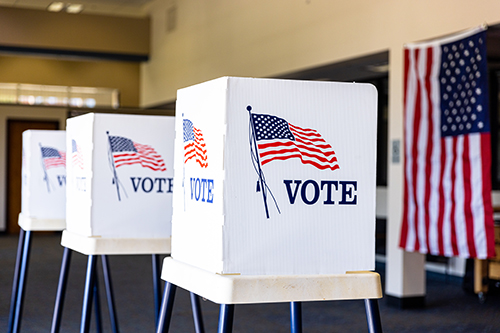Originally published in The Municipality
Get Help, from the Start
Know that you don’t know it all, and that you can benefit from others’ experience – and their help. In South Milwaukee, we recognized early on that we could benefit from the support of a third party, and we purposely chose a public relations firm, as we approached the referendum as a communication and education campaign from day one. The city chose Mueller Communications, a well-respected and connected local public relations firm that had previously worked with a local school district on a successful referendum education campaign. This helped in two key ways.
- First, they offered us an honest, impartial view of the funding problems facing us and potential solutions. They challenged us to present the information in a simple, understandable way that would resonate with residents, reminding us that not everyone is an expert in city budgeting.
- Mueller Communications also provided another set of hands to help with the day-to-day work necessary to educate the public and get a question on the ballot. From coordinating the survey and mailings, to consulting our website content, Mueller was invaluable in taking tasks off the plates of city staff.
You Get One Chance
South Milwaukee was facing a critical, immediate need to fund paramedic services. Early on, leadership identified a referendum as a potential solution to the immediate challenge. We were also cognizant that holding referendums too frequently could frustrate voters and undermine the credibility of elected officials.
It is important to remember the general public has limited knowledge of the budget decisions facing municipal leaders. The South Milwaukee Common Council discussed the paramedic funding challenge for several years and made budget decisions to maintain service. This deep knowledge led us to consider a referendum, and while we felt paramedic funding was a clear and compelling community need, we had to take a step back to effectively educate the community and take voters through the process, and gauge community interest. One year before the referendum vote, the council commissioned an options assessment to outline the budget challenges facing the City, as well as the potential funding solutions. The options assessment was used as the basis to create a community survey, which solicited opinions from South Milwaukee residents but also served as an educational tool that was mailed to all residents in May of 2017, six months before the referendum vote. An online version was also offered. The survey results were presented at a council meeting in July, and aldermen voted in August to proceed with the referendum less than two months later. Once the referendum was scheduled we implemented an education campaign over the course of three months consisting of direct mail, social media, a detailed website, and a series of public meetings.
Take the time to develop detailed resource materials for the public and establish a narrative that demonstrates the municipality did its due diligence before deciding to hold a referendum. For South Milwaukee, the options assessment explained the complexities of paramedic service and funding. We developed charts and graphs to complement the descriptions and show the impact of each potential solution on service levels and response times. The options assessment also documented the steps the City had already taken to cut costs and save taxpayer dollars. We used press coverage and social media to promote the options assessment and direct residents to read it on the city website, recognizing that we would also need to simplify the information for many people who didn’t want to take that deep of a dive into data.
Going to referendum was never a foregone conclusion. While we were not bound by the survey results, we pledged to take them seriously and act accordingly, including potentially not moving forward on the referendum. Response was strong – more than 1,350 responded for a response rate of 14%, considered very high by experts, even though respondents were not necessarily reflective of our population (43% of respondents were 65 years or older). Results indicated strong support for a referendum, as 60% of respondents said they would support paying higher property taxes to maintain existing fire and EMS; 64% said they would support doing the same to add two new police offers. This compares to 24% support for outsourcing EMS services and 41% support for making other budget cuts and service reductions to maintain fire and EMS services. In other words, residents spoke loudly and clearly. With these results and clear feedback, the South Milwaukee Common Council voted in August to put a referendum question on the November 7 ballot.
After you’ve developed comprehensive resource materials, take the time to establish concise and consistent messages that will help the public understand the basics of the issue. Municipal officials should use those key messages to guide their conversations with constituents when explaining the referendum. We synthesized the information from the options assessment into a two-page fact sheet that covered all of the key messages. Also remember that repetition is crucial – voters need to hear the same messages over and over in order for the information to resonate. We did two direct mail pieces educating voters on the campaign, one about a month ahead of the vote, and the second a week out: Both pieces included the same key messages presented with slightly different visual layouts.
Provide a wide range of opportunities for residents to get educated on the referendum, ask questions, and provide feedback. In addition to hosting our own information sessions, the mayor and city administrator spoke to a variety of community groups including the chamber of commerce, the lions club, and the local school board. We also used the mayor’s blog and social media to share information in addition to creating a dedicated phone number and email address for residents to direct questions.
The city can only educate around the referendum. It cannot advocate. Others, however, can, and they did in South Milwaukee. A third-party advocacy group formed prior to the election, led by the state and local firefighters union. The group delivered, entirely independent of the city, a get-out-the-vote effort that included direct mail pieces, door-to-door canvassing, phone banking, and social media activation. The advocacy work was likely a significant contributing factor to the more than 28% voter turnout in a special election, much higher than initial projections, and the final 2-to-1 “yes” vote. An organized opposition group never formed.
About the authors:




